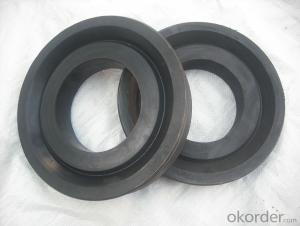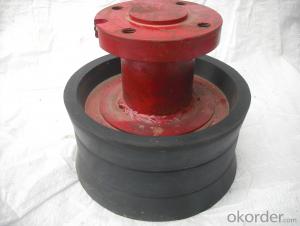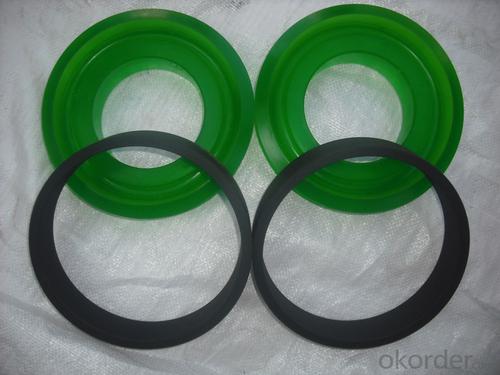ZOOMLION RUBBER PISTON IN POLYESTER DN200 WITH HIGH QUALITY
- Loading Port:
- Tianjin
- Payment Terms:
- TT OR LC
- Min Order Qty:
- 3 set
- Supply Capability:
- 500 set/month
OKorder Service Pledge
OKorder Financial Service
You Might Also Like
ZOOMLION RUBBER PISTON WITH FIBER DN200
Schwing/ Sany/PM/Zoomlion concrete pump rubber piston
name | Concrete pump piston |
size | DN200 for Schwing DN230 for Schwing DN200 for PM entirety piston DN230 for PM entirety piston DN180 for Zoomlion piston DN200 for Zoomlion piston DN220 for Zoomlion piston DN230 for Zoomlion piston DN180 for Sany piston DN195 for Sany piston DN200 for Sany piston DN230 for Sany piston DN260 for Sany piston DN280 for Sany piston Other sizes and types upon request |
Material | PUR Polyurethane,natural rubber |
Applacation | Used in concrete pump truck,concrete pump,Hydrulic ram system in Construction work equipment
|
Serving brands of mounted truck concrete pump and concrete pump | Sany ,PM, Zoomlion,Schwing,CIFA and so on |

- Q: Where can I buy concrete pump spare parts?
- Concrete pump spare parts can be purchased from various sources. One possibility is to contact the manufacturer of your concrete pump. Typically, they have authorized dealers or distributors who sell genuine spare parts for their equipment. This guarantees that the parts are of high quality and compatible with your specific pump model. Another option is to explore specialized construction equipment suppliers or dealers in your locality. These companies often carry a wide range of spare parts for different types and brands of concrete pumps. You may either visit their physical stores or browse their websites to check if they have the specific parts you require. Alternatively, online marketplaces and platforms offer a convenient way to buy concrete pump spare parts. Websites such as Amazon, eBay, and Alibaba have an extensive selection of spare parts from sellers worldwide. You have the opportunity to compare prices, read reviews, and select the parts that best meet your needs. Before finalizing your purchase, it is crucial to ensure that you are buying from a reputable source. Look for sellers with positive feedback or ratings, and verify if they provide warranties or return policies. Additionally, take into account factors like shipping costs, delivery times, and customer service when determining where to purchase your concrete pump spare parts.
- Q: What is the purpose of a concrete pump hydraulic oil filter?
- The purpose of a concrete pump hydraulic oil filter is to remove contaminants and impurities from the hydraulic oil, ensuring that the oil remains clean and free from any particles that could potentially damage the pump's components or negatively affect its performance.
- Q: How often should wear rings be replaced in a concrete pump?
- The frequency at which wear rings should be replaced in a concrete pump depends on several factors including the type of pump, the quality of the wear rings, the volume of concrete being pumped, and the operating conditions. In general, wear rings are components that experience significant wear and tear due to the abrasive nature of concrete. As a result, they will eventually need to be replaced to maintain the pump's efficiency and prevent potential damage to other parts of the pump. Typically, wear rings should be inspected regularly during routine maintenance checks. The wear patterns and extent of damage will determine whether replacement is necessary. In some cases, wear rings may last for several thousand hours of operation, while in others, replacement may be required more frequently. It is recommended to consult the pump manufacturer for specific guidelines on wear ring replacement intervals based on the pump model and operating conditions. They may provide recommendations based on their expertise and knowledge of the pump's design and performance. Ultimately, the goal is to ensure that the concrete pump operates smoothly and efficiently, minimizing downtime and maximizing its lifespan. Regular inspections and proactive replacement of wear rings when necessary will help achieve this objective.
- Q: Is the main pump of the concrete pump electric control or hydraulic control?
- General Separated and Closed Open Electromagnet Control Displacement (Current)
- Q: How do I maintain and clean concrete pump spare parts?
- To ensure the long life and smooth operation of concrete pump spare parts, it is crucial to maintain and clean them. Follow these steps to accomplish this: 1. Conduct Routine Inspections: Begin by carefully examining the spare parts for signs of wear, cracks, or damage. This step is essential for identifying potential issues that require immediate attention. 2. Apply Lubrication: To minimize friction and prevent seizing, apply lubricant to moving parts like bearings, pistons, and cylinders. 3. Thoroughly Clean: Employ a high-pressure washer or hose to thoroughly clean the spare parts. Eliminate any accumulated dirt, debris, or concrete residue, paying particular attention to hard-to-reach areas. 4. Prevent Rust: Guard metal parts against corrosion by applying a rust preventive coating. This step is especially important if the spare parts are exposed to moisture or inclement weather conditions. 5. Proper Storage: Store the spare parts in a clean and dry location to shield them from moisture, dust, and other contaminants. Avoid directly stacking them on the ground to prevent damage. 6. Regular Maintenance: Establish a maintenance schedule and adhere to it. Adhere to the manufacturer's guidelines for routine tasks such as replacing filters, checking oil levels, and inspecting seals. Regular maintenance aids in the detection of potential issues before they escalate into major problems. 7. Seek Professional Assistance: If you are uncertain about how to maintain or clean specific spare parts, it is advisable to seek professional assistance. Concrete pump spare parts are intricate and necessitate expert handling. Remember, proper maintenance and regular cleaning of concrete pump spare parts not only prolong their lifespan but also enhance the overall performance and efficiency of your concrete pump.
- Q: What are some common issues with concrete pump hoses and how can they be prevented?
- Some common issues with concrete pump hoses include blockages, leaks, and premature wear. To prevent these issues, it is important to regularly inspect and clean the hoses to remove any debris or hardened concrete. Additionally, ensuring that the hoses are properly supported and avoiding excessive bending or twisting can help prevent damage and premature wear. Regular maintenance, such as replacing worn-out parts and avoiding excessive pressure, can also help prolong the lifespan of concrete pump hoses.
- Q: What is the function of a concrete pump hopper grate handle?
- The function of a concrete pump hopper grate handle is to provide a means for operators to easily lift and remove the grate from the hopper, allowing for inspection, maintenance, or cleaning of the pump's interior.
- Q: What is the function of a concrete pump hopper grate clamp?
- A concrete pump hopper grate clamp is a device used to secure the hopper grate in place on a concrete pump. The hopper grate is an essential component of the pump that acts as a filter to prevent large debris and foreign objects from entering the pump system. The clamp is designed to hold the hopper grate tightly in place, ensuring that it remains secure during the pumping process. By keeping the hopper grate in place, the clamp helps to maintain the integrity of the pump system and prevent any potential damage or blockages that could occur from the entry of unwanted materials. Overall, the function of a concrete pump hopper grate clamp is to provide a secure and reliable way to keep the hopper grate in place, allowing for smooth and efficient concrete pumping operations.
- Q: What are the different types of concrete pump hoses?
- There are generally two types of concrete pump hoses: steel-reinforced hoses and fabric-reinforced hoses. Steel-reinforced hoses are stronger and more durable, suitable for high-pressure applications and long-distance pumping. Fabric-reinforced hoses are lightweight and flexible, ideal for smaller projects and shorter pumping distances.
- Q: What is the importance of a concrete pump control valve?
- A concrete pump control valve plays a critical role in the operation of a concrete pump. It is an essential component that allows for precise and efficient control of the flow and pressure of the concrete being pumped. The importance of a concrete pump control valve can be understood by considering its various functions. Firstly, it regulates the flow of concrete from the hopper to the pumping cylinders. By adjusting the valve, operators can increase or decrease the flow rate to match the specific requirements of the project. This ensures that the right amount of concrete is being pumped, preventing wastage and optimizing productivity. Secondly, the control valve allows for precise control of the pressure in the pumping cylinders. By adjusting the valve, the operator can increase or decrease the pressure to maintain a consistent and steady flow of concrete. This is crucial in preventing blockages or clogs in the concrete pump system, which can lead to downtime and costly repairs. Furthermore, the control valve enables the operator to switch between different pumping modes, such as high-pressure pumping or low-pressure spraying. This versatility allows for the efficient execution of a wide range of concrete pumping tasks, from pouring foundations to spraying concrete for decorative purposes. In addition to its functional importance, a concrete pump control valve also contributes to the safety of the pumping operation. It allows operators to stop or reverse the flow of concrete in case of emergencies or equipment malfunctions. This feature ensures that any potential hazards are quickly addressed, minimizing the risk of accidents and injuries. Overall, the importance of a concrete pump control valve lies in its ability to provide precise control over the flow and pressure of concrete during pumping operations. It ensures efficiency, productivity, versatility, and safety, making it an indispensable component of any concrete pumping system.
Send your message to us
ZOOMLION RUBBER PISTON IN POLYESTER DN200 WITH HIGH QUALITY
- Loading Port:
- Tianjin
- Payment Terms:
- TT OR LC
- Min Order Qty:
- 3 set
- Supply Capability:
- 500 set/month
OKorder Service Pledge
OKorder Financial Service
Similar products
Hot products
Hot Searches
Related keywords






























